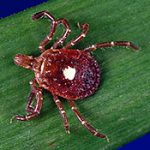The Lone Star Tick is very widespread in the United States ranging from Texas to Iowa in the Midwest and east to the coast where it can be found as far north as Maine. It is most common in wooded areas, particularly in forests with thick underbrush.
Like all ticks, it can be a vector of diseases including human granulocytic ehrlichiosis (Ehrlichia chaffeensis), canine and human granulocytic ehrlichiosis (Ehrlichia ewingii), tularemia (Francisella tularensis), and Southern tick-associated rash illness (STARI, possibly caused by the spirochete Borrelia lonestari). STARI exhibits a rash similar to that caused by Lyme disease but is generally considered to be less severe.
Though the bacteria responsible for Lyme disease, Borrelia burgdorferi, has occasionally been isolated from Lone Star ticks, numerous vector competency tests have demonstrated that this tick is extremely unlikely to be capable of transmitting Lyme disease. There is evidence that the A. americanum saliva inactivates Borrelia burgdorferi more quickly than the saliva of Ixodes scapularis.

